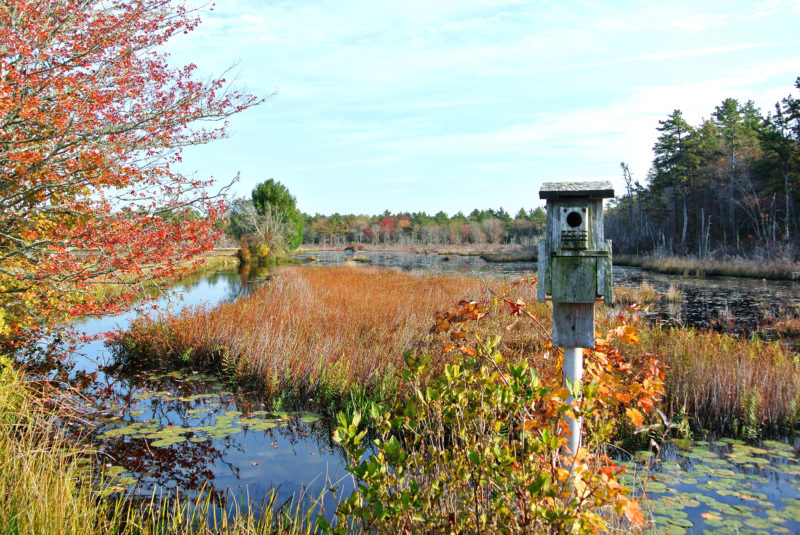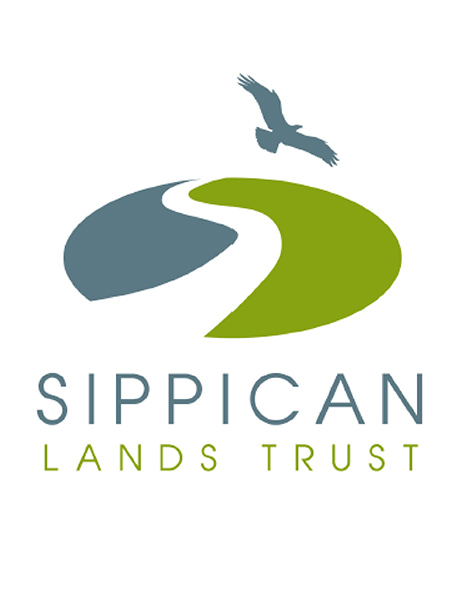Aucoot Woods: White Eagle Parcel
Even to its regular visitors, the secluded White Eagle Parcel in Marion’s Aucoot Woods feels a bit like a secret. The trails at this Sippican Lands Trust property encircle an active cranberry bog and lead deep into the forest. Explorers of all ages can discover a mix of habitats here, and the fascinating wildlife that call them home.
Features

Explore a wealth of protected freshwater wetlands, including a large active cranberry bog, at the White Eagle Parcel of Aucoot Woods in Marion.
White Eagle is one of two publicly accessible parcels of Aucoot Woods, a stretch of more than 1,000 acres of protected land in Marion. (The other is the Radio Tower Parcel to the north.) The White Eagle Parcel stands out for its diverse scenery: with deep forests, running streams, freshwater wetlands, and acres of cranberry bogs, it’s a fascinating place to explore.
The White Eagle Parcel is an actively cultivated cranberry bog, and has been producing cranberries (primarily of the Early Black and Howes varieties) continuously for at least 80 years. Take a walk here in late fall, when the bogs are flooded for harvesting, and you’ll find yourself surrounded by stunning views of bright red berries floating to the water’s surface.
Trails
Explore a network of roughly three miles of looping trails at the White Eagle Parcel. The trails here connect with additional trails through Aucoot Woods and neighboring Goldavitz Bog; you can walk for as little as half an hour or hike through the whole afternoon, depending on which path you take. (Download trail map)
To get to the parking area, turn onto Parlowtown Road from Route 6. Turn left onto the dirt road and continue until you see the Sippican Lands Trust sign and kiosk.
For an easy walk with striking views, stick to the wide, flat paths that weave among the bogs and freshwater swamps. The hour just before sunset is an especially magical time to take a walk here, when flooded wetlands surround you with reflections of the sky.
For a longer hike through the woods, follow the red trail around the cranberry bogs until it slips into the woods. This trail forms a large loop through the forest north of the bogs, eventually returning you to Goldavitz Bog. From the red trail, you also can detour north to the Radio Tower Parcel. Make sure you follow the trail makers to stay on path, and prepare for a muddy journey in the spring.
Intrepid explorers can take the white trail, which loops southwest from the parking area through the wetlands behind the bogs. This scenic path, lined with bridges and bog boards, offers an intimate view of a freshwater wetland. However, parts of this trail can be very swampy, so we recommend that you walk this way only if you’re wearing high waterproof boots.
Habitats & Wildlife
White Eagle protects a mixed habitat of upland pine and hardwood forests alongside freshwater wetlands and cultivated cranberry bog. These varied habitats make White Eagle a riot of color that changes from season to season. In the spring, look for the vibrant pink of lady slippers growing on the forest floor, while fall brings the rich reds of cranberry plants, cranberries, and maple leaves.
These environments also preserve important wetland habitat for a variety of animals. Two rare species of turtles, the eastern box turtle and the spotted turtle, have been found here; look for them paddling through the water around the cranberry bogs or basking in the sun. In the forest, keep an eye out for signs of deer, fox, and mink. White Eagle is also an excellent birding destination; water-loving species like buffleheads and other ducks are often spotted here, as well as the occasional bald eagle.

 Download Property Map
Download Property Map